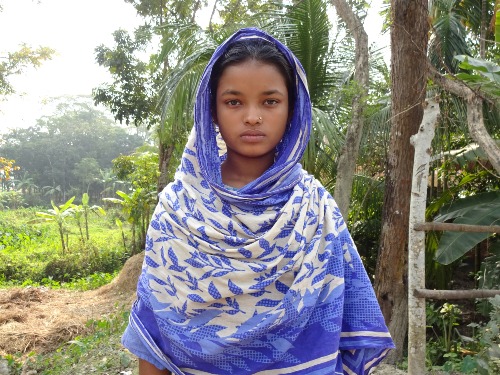News
Budding photographers in post-cyclone Bangladesh capture wreckage – and resilience
- 12 May 2021
News
PATUAKHALI DISTRICT, Bangladesh – One year ago this month, Cyclone Amphan unleashed its fury across Bangladesh, killing 26 and damaging thousands of homes, agricultural lands, bridges and roads. But even as the headlines receded like the waters and the news cycle moved on like the winds, four young budding photographers captured life in the south-central part of the country, an area already burdened by the pandemic.
“Visiting a site of a natural disaster is difficult, because you can truly feel the misery of the people affected by it,” said Md. Naimur Rahman Zihad, 19. “Documenting such a site, however, is even more challenging and heartbreaking.”
He was one of four volunteers who spent four months learning to take pictures and documenting the lives of women and girls affected by natural disasters in Bangladesh, with camera equipment and virtual training supplied by UNFPA and partner Concerned Women for Family Development (CWFD). Immediately after the cyclone, UNFPA distributed nearly 1,500 menstrual hygiene management kits to adolescent girls and provided psychosocial support in affected communities, but the photo documentary project didn’t begin until the fall.
The volunteers chronicled daily village life in two places, Patuakhali Sadar Upazila and Kalapara Upazila, and the objectives were threefold: learn a skill, build empathy by listening and sharing stories, and raise awareness on the challenges communities face in recovering and rebuilding.
“People barely had food to eat or a house to live in, but they were still so cheerful and welcoming. Some even offered us food!” said 22-year-old volunteer Sumaia Akter. “When I learned about their struggles, I felt so grateful for the things I have in life.”

Volunteer Md. Tajbit Ahammad Barat, 20, met a pregnant woman who walked miles to use a tin outhouse that her family built. The cyclone eroded the soil inside, and cloth now served as walls. “When ships or boats sail by, she feels very insecure and wishes to get it repaired,” he recalled. “Since the family has been living from hand to mouth after the cyclone, even doing something this small is not possible.”
After the project ended, a selection of photographs was used to raise awareness of community needs among the public. But the trove of hundreds of images is not all that remains. “After this experience, I am much more understanding of the situations other people are going through,” said volunteer Rujina Begum, 18. “It is amazing how people can manage to smile even when they are struggling with meeting their basic needs. It is a lesson for me to always appreciate all the little things I have.”